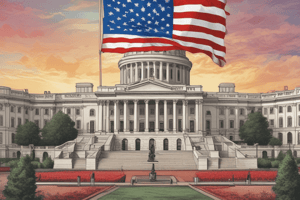Podcast
Questions and Answers
What is the first step in the legislative process?
What is the first step in the legislative process?
- Introduction (correct)
- Committee review
- Floor debate
- Voting
What is the purpose of a committee review in the legislative process?
What is the purpose of a committee review in the legislative process?
- To sign the bill into law
- To debate the bill on the floor of the chamber
- To gather input from experts and the public and mark up the bill (correct)
- To hold a final vote on the bill
What happens after a bill is introduced in the legislative process?
What happens after a bill is introduced in the legislative process?
- It is debated on the floor of the chamber
- It is put to a final vote
- It is referred to a committee for review (correct)
- It is sent to the executive branch for signing
What is the purpose of a conference committee in the legislative process?
What is the purpose of a conference committee in the legislative process?
What happens if a bill passes in both chambers but is not identical?
What happens if a bill passes in both chambers but is not identical?
What is the final step in the legislative process?
What is the final step in the legislative process?
Who is responsible for reviewing and debating a bill in the legislative process?
Who is responsible for reviewing and debating a bill in the legislative process?
What happens during floor debate in the legislative process?
What happens during floor debate in the legislative process?
What is the purpose of the committee markup in the legislative process?
What is the purpose of the committee markup in the legislative process?
What is the result of a successful vote in the legislative process?
What is the result of a successful vote in the legislative process?
Flashcards are hidden until you start studying
Study Notes
Legislative Process
Introduction
- The legislative process is the process by which a bill becomes a law
- It involves several stages, including introduction, committee review, floor debate, voting, and signing into law
Stages of the Legislative Process
- Introduction
- A member of the legislature introduces a bill in either the House of Representatives or the Senate
- The bill is written in a specific format and typically includes a statement of purpose and the text of the proposed law
- Referral
- The bill is referred to a committee, which is responsible for reviewing and debating the bill
- The committee may hold hearings, gather input from experts and the public, and mark up the bill (make changes or amendments)
- Committee Review
- The committee reviews the bill and may:
- Approve the bill and send it back to the full chamber for consideration
- Reject the bill and prevent it from moving forward
- Amend the bill and send it back to the full chamber for consideration
- The committee reviews the bill and may:
- Floor Debate
- The bill is debated on the floor of the chamber where it was introduced
- Members of the legislature may offer amendments, and there may be votes on these amendments
- Voting
- The bill is put to a vote in the chamber where it was introduced
- If it passes, it is sent to the other chamber (e.g. from the House to the Senate, or vice versa) for consideration
- Conference Committee
- If the bill passes in both chambers but is not identical, a conference committee is formed to iron out the differences
- The conference committee is made up of members from both chambers
- Final Vote
- The bill is put to a final vote in both chambers
- If it passes, it is sent to the head of the executive branch (e.g. the President) for signing
- Signing or Veto
- The head of the executive branch signs the bill into law, or vetoes it
- If vetoed, the bill is sent back to the legislature, which can try to override the veto with a two-thirds majority vote in both chambers
Legislative Process
Introduction
- The legislative process involves transforming a bill into a law through multiple stages
- These stages include introduction, committee review, floor debate, voting, and signing into law
Stages of the Legislative Process
- A bill is introduced in either the House of Representatives or the Senate by a member of the legislature
- The introduced bill includes a statement of purpose and the proposed law's text
Committee Review
- The bill is referred to a committee responsible for reviewing and debating it
- The committee may hold hearings, gather expert and public input, and mark up the bill
- The committee can approve, reject, or amend the bill before sending it back to the full chamber
Floor Debate and Voting
- The bill is debated on the floor of the introducing chamber
- Members can offer amendments, which may be voted on
- The bill is put to a vote in the introducing chamber
- If it passes, it is sent to the other chamber for consideration
Conference Committee and Final Vote
- If the bill passes in both chambers but is not identical, a conference committee iron out the differences
- The conference committee consists of members from both chambers
- The bill is put to a final vote in both chambers
- If it passes, it is sent to the head of the executive branch for signing
Signing or Veto
- The head of the executive branch signs the bill into law or vetoes it
- If vetoed, the bill is sent back to the legislature, which can override the veto with a two-thirds majority vote in both chambers
Studying That Suits You
Use AI to generate personalized quizzes and flashcards to suit your learning preferences.




